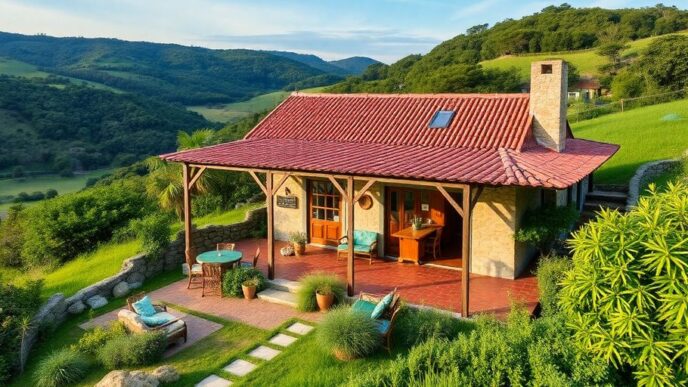We love the Ocean Roadies YouTube channel, and they have a fascinating video about visiting the Schist Villages in Portugal, and the castle of Lousa.
Nestled deep in the mountains of Portugal, the Castle of Lousã is a captivating site steeped in legend and history. This enchanting castle, once a refuge for royalty, is surrounded by stunning landscapes and the remnants of ancient schist villages, offering a glimpse into a quieter, bygone era.
Need To Know
- The Castle of Lousã is linked to the tragic tale of King Arouce and Princess Peralta.
- The region features 27 schist villages, many of which are abandoned but slowly reviving through tourism.
- The hiking trail through these villages offers breathtaking views and a unique connection to nature.
The Legend of the Castle
The Castle of Lousã, built by King Arouce of Conímbriga, served as a sanctuary for him and his daughter, Princess Peralta. When their kingdom was attacked by Prince Lausus, the king locked his daughter away to protect her. Tragically, both the king and the prince perished in battle, leaving the princess to mourn her lost love within the castle’s walls. It is said that if you listen closely, you can still hear her cries echoing through the mountains.
Exploring the Castle
Upon arriving at the castle, visitors are greeted by its impressive structure, which has been well-preserved over the years. The castle’s strategic location in the mountains provided a perfect hideaway from enemies. As you ascend the ancient stairs, the view from the top reveals a breathtaking panorama of the valley below, showcasing the natural beauty that surrounds this historic site.
The Schist Villages
After exploring the castle, the adventure continues with a hike along the Route of the Schist Villages. This trail leads through three of the 27 villages made from schist rock, each with its own unique charm and history. The villages include:
- Castelo Novo – Known for its stunning views and remnants of old houses.
- Chiqueiro – A quieter village where nature reigns supreme, with a few inhabitants still calling it home.
- Talasnal – The most vibrant of the three, featuring cafes and a lively atmosphere.
These villages, some dating back to the 12th century, offer a glimpse into a different way of life, where the pace is slower and the connection to nature is profound. While many of the homes are abandoned, a few residents remain, drawn to the tranquility and beauty of the mountains.
Hiking Through History
The hike through the schist villages is not just a physical journey but also a historical exploration. As you walk along rocky terrains and past the ruins of old houses, you can almost feel the stories of the past come alive. The path winds through lush landscapes, with the sound of flowing rivers accompanying your steps.
A Reflection on the Journey
After visiting the three villages, one can’t help but reflect on the beauty of the region. Each village has its own character, from the abandoned charm of Castelo Novo to the lively atmosphere of Talasnal. The experience of hiking through these historical sites is both invigorating and humbling, reminding us of the rich tapestry of life that once thrived in these mountains.
As the day winds down, a refreshing swim in the pool near the Castle of Lousã offers the perfect conclusion to an adventurous day. The combination of history, nature, and the thrill of exploration makes this region a must-visit for anyone traveling through Portugal. Whether you’re drawn by the legends of the castle or the serene beauty of the schist villages, Lousã promises an unforgettable experience.
If you enjoyed this adventure, consider giving teh Ocean Roadies thumbs up and subscribing for more explorations of ghost towns and hidden gems in Portugal and beyond!













